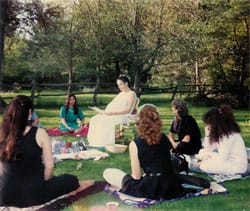
In my last blog I suggested the importance of transforming the experience of birth from being scared to being sacred. The simple switching of letters in this anagram is a metaphor for how birth has been transmuted in the 20th century from a woman-centered labor of love to a medicalized emergency waiting to happen. When birth was removed from the home and relocated into hospitals for the sick, women became patients rather than birthing mothers, and their power was attenuated in an environment in which the one with the power is the doctor. It can also be said for the midwife, the birth care provider in places like the UK, where the midwife is the first point of contact in the maternity system. Whereas the birth attendant was a guest in the house of the woman giving birth through the first half of the 20th century, women who give birth in hospitals are the guests whose needs are subordinated to the policies and protocols of the bureaucratic institution. What a world of difference there is in those two situations.
Scared Birth
Hospitals are not places where we generally feel in power, except maybe if we work in one. For the most part, birthing women are expected to journey to a place that is organized for the benefit and convenience of its employees, and not for their special needs when they are feeling vulnerable. There are protocols and policies that women are expected to abide by, despite the fact that those rules and regulations might subject them to undue harm in the course of their labor. Once a woman puts on a hospital jonny, she is transformed into a patient, and this often has a powerful impact on her sense of agency and control. There is no question that obstetricians are grossly over qualified for normal birth, and the tendency to interfere can be irresistible, and if a woman is there long enough she will endure a cascade of interventions that proceed like dominoes. The need to do something is compelling for doctors who are not very good at sitting on their hands and letting nature take its course. The recent trend to induce labor has caused cesarean section rates to skyrocket, since about 65% of inductions fail, especially when the mother’s body is not ripe for labor. For women at the end of their pregnancies, feeling heavy and ready to be un-pregnant again, the impulse to be induced is enormously seductive. Then there are strategies that doctors use that apply pressure to mothers, like playing the dead baby card, or even the very gentle suggestion “I’m a little concerned about the baby.” Who is going to push back when such a statement is made? What mother will resist doing the right thing for her baby if the person in authority implies that something terrible might happen if she doesn’t do what she is told?
What is the alternative?
What if it didn’t have to be this way? What would need to happen for women to reclaim the power of giving birth using their own power, their own steam, spontaneously, instinctively and uninhibited by others or policies? We would need to loosen the grip that obstetrics has over the process of parturition. Even in places like the UK where midwives prevail over the birth process, they are influenced by the presence of doctors (in many cases these are doctors in training) in how they make judgments on what actions to take. As employees of the hospital, they are bound by the protocols and policies in place, most of which are written by the consultant obstetricians. A very positive development that is happening now is the growth of midwifery led units (MLU) in the UK, most of which are within the hospital grounds. This is the kind of loosening that moves birth toward a more woman-centered experience and one that is more in tune with what mothers want and need. I had the pleasure of visiting one of these units in a local hospital that really paid attention to what facilitates a normal birth, and each room was equipped with a pool, and a number of other elements that create the kind of container that allows a woman to tap in to her instincts while she’s in labor. These are the kinds of changes that will transform a birth from scared to sacred.

Sacred Birth
What is sacred birth? It acknowledges the rite of passage that it is, an initiation into parenthood. Sacred birth also recognizes the woman as a whole person, not just a collection of body parts, and she brings many levels of experience into birth – physical, mental, emotional and spiritual. This holistic approach to birth includes a respect for the sanctity of the first contact when a new soul meets its mother on the outside of the womb for the first time, softening the moment of separation. Sacred birth is wondrous and awesome, intimate and loving, quiet and respectful of what the birthing woman needs. And sacred birth is powerful, and the power resides in the mother who is encouraged to follow her instincts, to move in ways that ease the pain, to be cherished by her partner as she brings forth life, and to transcend the difficulties that arise by being in tune with her own experience. She is the star, the producer and the director of her birth drama. It’s much easier to have a sacred birth at home, where the mother is in familiar territory and can do what she likes. It’s possible to give birth in a birth center and for it to be a sacred moment. It’s much more of a challenge to create this in the hospital, with all its policies, but it’s not impossible. It just takes a lot more determination.
In order to restore the sacred aspects of birth, we need to eliminate the fear. The best way to do this is with a comprehensive level of knowledge about the physiology of the birth process and what women can do to work with it. The practical application of this knowledge grounds it in the body and becomes the cellular preparation for birth. It means grappling with some of the psychological aspects of the fears – fear of the unknown, fear of the power, and fear of the pain. Women don’t need to learn how to give birth; they need to unlearn some of the conditioning that makes it difficult for them to trust their bodies to do what needs to be done. It’s so much easier to trust our bodies to birth powerfully if we know what to expect and what’s likely to happen. ‘We create our reality’ in the best possible way when we have the information we need to make informed decisions and to negotiate with care providers when the unexpected happens. Knowledge is power, and it empowers birthing women to go with the flow.
Another tool that helps to make birth a sacred event is a birth plan. It’s important to write a plan that has a number of contingencies in it, in the event that something happens to change the course of action. This way a woman doesn’t have to abandon the choices or preferences that are important to her. Nothing is engraved in stone, and a good birth plan is flexible and inclusive of all possibilities. It is a terrific communication tool. When you talk about a plan with the doctor or midwife, you can see the areas where there is agreement and those where there are differences. Then you can negotiate what’s possible when there are disagreements. In some cases, a woman might realize she needs to change practitioners because there is disagreement that can’t be bridged. A flexible birth plan is an opportunity to see what’s possible so that there are no surprises during the main event. For more information about creating a birth plan, see a previous blog that I wrote.
Transforming Scared to Sacred
With knowledge and a plan, a woman is ready to give birth according to her own preferences. An attitude of being active while giving birth is another way of taking charge and being in control. She is moving and using gravity as the way to help her baby being born. She is supported by her partner, who also has been educated to understand what is going to happen and how he/she can be practically useful and emotionally supportive. When a woman in labor is supported in this connected way, both she and her partner grow in their capacity to be there for each other, which will help immensely when they start parenting together. A well prepared partner can make a big difference in how the birth unfolds, and can be an instrumental positive influence, whether it’s negotiating with hospital staff, or protecting her from undermining comments from insensitive people in her environment. So often I hear women complain that their partners weren’t there for them during birth, and when partners are engaged in meaningful ways this can prevent this kind of discontent. Through my work in The Birth Empowerment Workshop® I know how important it is to strengthen the relationship of a couple who are about to become parents.

Another way to evoke a sacred birth is to create a Blessingway, a ceremony that is based on the Navajo tradition of honoring the pregnant woman and her unborn child for a safe journey of birth. Blessingway into Birth is a way of connecting with the divine and marking the rite of passage in a way that creates a picture of success and sends it into the future as the woman’s personal pathway. Those who bear witness are the woman’s community and they share their blessings and their energy in ways that connect her with the flow of nature. It is both an empowering and a spiritual ceremony and those who take part are transformed by the power and magic of the ritual.
And the final piece to a sacred birth is the acknowledgement that a new spirit is arriving on the earth plane, and we need to welcome these new souls with a soft landing. When birth is gentle and compassionate, we provide the best situation for a sensitive soul to emerge. We know that newborns are born with enormous intelligence, and the intelligence that created the form of this baby informs the growth and development of the new human being. This is something to be respected and honored. This next generation of babies being born are coming in ‘cable ready’, with capabilities we can only imagine. Let’s welcome them as the sacred beings that they are. Namaste.

I hope you have enjoyed this post. Use the search bar below to find other interesting content on this site.
Post Categories








Very well said!
How true my dear sister. I know from personal experience of 3 births, waterbirths, at home, birth center and hospital and my thesis project on birth setting choices in women and of course my training as a doula and coach to a number of families. That this is the truth. For me it was simply a spiritual experience and birth tells the story of that Mom in that moment in her life.
Beautifully put. It is not change but resistance to change that takes so much time. I sometimes fear that the current dependance on medicalised care will be with us until every woman is booked in for an elective CS. If we are to change to a more natural care base for labour then the change has to come from women themselves. We have to go back to our feminist roots and demand midwife led care at home or in a midwife led birth center. But, do not expect all midwives to understand the anatomy and physiology of normal labour for they too have been subjected to the media hype that is painful labour contractions. Uterine smooth muscle was never designed to cause the sensation of pain when contracting under normal conditions. It is the way that we react to labour that makes it painful. Relaxation techniques are the answer and should be taught to women before labour day arrives. When we labour without the influence of adrenalin, the labour tends to be so much easier and quicker. Please keep spreading the word. Ann x http://www.painfreelabour.blogspot.co.uk
Ann, your comment is true on so many levels. I went back to my feminist roots when I immigrated to the UK as a postgraduate student using my case notes as a birth professional as the data for my PhD research in Women’s Studies: The Childbirth Educator as Ethnographer: A Feminist Retrospective Ethnography of a Professional Practice. I had been a childbirth educator for 20 years prior to that, and relaxation was a fundamental tool for managing pain in labor. As a result of that emphasis I also became a hypnotherapist and used these tools with my clients before hypnobirthing became such a phenomenon.I believe we are on the same page about how we can help women claim their power to give birth in empowered ways.
Thank you for sharing the spiritual side of birth. Indeed birth has become a medical event specially here in Singapore where most birth happen in the hospital and women don’t believe hey can do it and often surrender to drugs for pain relief. I agree with Diane that relaxation is key to a comfortable birth as what HypnoBirthing moms do. I am now looking for people here who can guide women in search of becoming a mom through connecting with the soul and for expectant couples to truly connect with their unborn baby through a ceremony. I would love to see the magical moment to happen in the near future.
Thank you for your comment, Kong Choon Yen. I share your concerns about how medicalized birth has become. The sad news is that it’s been that way for at least 40 years that I’m aware of. I hope that this blog moves us one step in the right direction of honoring the divine moment that birth can be, if we allow it to be. Blessed be.
Hi. Sooooo true. I am a volunteer walk leader, leading women and babies in health walks, the most positive part being the coffee and chats afterwards! As a midwife on long term sick leave, the women often share their birth stories. I hear much about disempowerment and fear. Interestingly, this is how many practicing midwives feel, working within the current climate. I loved reading your blog and wish that women and midwives could achieve your ideology.
I’m delighted that you loved reading the blog, Susan. I love the idea of being a walk leader – I’ve not heard of that. I’m not sure women realize that birth can be an empowering experience, and that’s why I put a premium on education for birth. It works wonders on reducing fear and letting women know what’s possible. Then they can create a birth that will bring joy and satisfaction and live on in their memories as magical.
Diane, your words could not have resonated more with me. I have shared your article with my husband and a coworker who is a huge advocate of sacred birth. I am a birth center midwife (that’s where my heart is and I have Birth center experience) working in a hospital, advocating for sacred birth. Your blog has sparked enthusiasm and fosters some ideas. I look forward to anyone’s input as to creating sacred birth in a hospital setting.
Thanks again,
Cathy Rudolph CNM.
Your comments warm the heart, Cathy, that midwives are looking for ways to make birth more sacred in hospitals. Thank you for sharing the blog, and if it has sparked enthusiasm and ideas for change, then that’s wonderful. Many blessings for your efforts on behalf of birthing women.